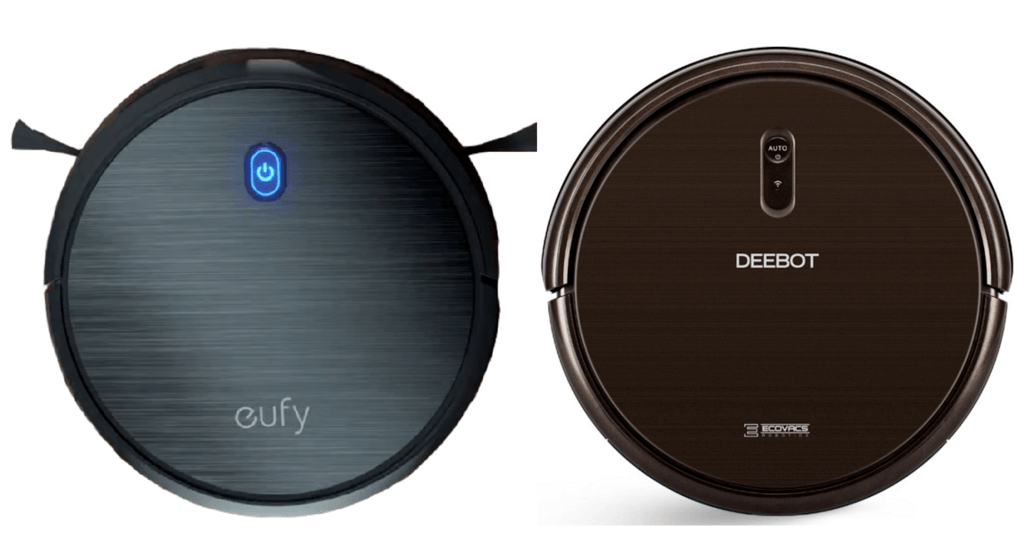Budget robotic vacuums, or entry-level as they are also known, are becoming more and more popular in homes across the country. Not only for their lower price tag but also for their ability to clean sufficiently enough for most homes. The Eufy 11S and the Ecovacs Deebot N79S are two such robots and the two I will compare today.
While each offers a lower price tag than the more expansive and feature filled competitors, they also give you with enough power to get the job done; provided you can live with some features not being available and others being sub-par.
This review will examine those features (or lack thereof) and how the two robots stack up against each other in a side by side showdown. Which one is right for you? That depends on how you feel about the capabilities of each option. My money, if you care to know, goes to the Ecovacs N79S.
Contents
- 1 The Differences between These Robot Vacuums
- 2 The Similarities between the Two
- 3 Specifications Chart
- 4 Comparing The Vacuums in Detail
- 5 Frequently Asked Questions
- 5.1 Q. What do the letters in the model names mean? Are they important?
- 5.2 Q. I heard the N79S only works with Amazon Alexa and nothing else, is this true?
- 5.3 Q. I want my cat to ride on my robot can I…
- 5.4 Q. Can I wash and reuse the filters?
- 5.5 Q. Do I have to do anything to keep the robot running right?
- 6 What I Like About the Eufy
- 7 What I Like About the Ecovacs N79S
- 8 In Conclusion
The Differences between These Robot Vacuums
[easyazon_image align=”none” height=”500″ identifier=”B079QYYGF1″ locale=”US” src=”https://smartrobotichome.com/wp-content/uploads/2019/01/51boLn7dKxL.jpg” tag=”srh-easyazon-20″ width=”500″]
[easyazon_image align=”none” height=”500″ identifier=”B077HW9XM7″ locale=”US” src=”https://smartrobotichome.com/wp-content/uploads/2019/01/41U3MfvI7JL.jpg” tag=”srh-easyazon-20″ width=”500″]
While they are similar in size, appearance and most abilities, there are differences that you should be aware of. Those differences could make or break your decision and are listed below.
- The Ecovacs N79S has a smaller collection bin capacity than that of the Eufy 11S.
- The 11S doesn’t have a HEPA quality filter like the N79S does.
- At maximum speed, the Ecovacs can produce more suction power than the Eufy.
- The Eufy 11S comes with a remote control where the Deebot N79S has wireless communications, including a mobile app and voice commands.
- The Eufy can detect when it is on carpet and adjust its suction accordingly; the Ecovacs cannot.
- Eufy will clean low and medium pile carpeting; Ecovacs will only clean low pile carpeting.
The Similarities between the Two
Some things are meant to be similar. Robots have a lot of the same parts and same functions. Let’s take a look now at how these two are the same.
- Each model has the same sized battery with the same milliamp hours.
- Both boast a runtime of up to 100 minutes (under perfect conditions).
- The Eufy and the Ecovacs Deebot each rely on their sensors only for navigation and do not have a mapping ability.
- Both robots can be scheduled for cleaning at specified times.
Specifications Chart
I present to you, here, a chart for an easy visual side by side comparison chart. You can see, at a glance, how the two combatants stack up against each other.
| Eufy 11S Robovac | EcoVacs Deebot N79S | |
| Dimensions | 13x13x2.8 inches | 13x13x3.1 inches |
| Weight | 5.51 pounds | 6.7 pounds |
| Battery | 2600mAh lithium-ion | 2600mAh lithium-ion |
| Runtime | Up to 100 minutes | Up to 100 minutes |
| Recharge | 4 hours | 3 hours |
| Automatic Recharge | Yes | Yes |
| Automatic Resume | No | No |
| Filter | High-performance | 3-Stage HEPA |
| Collection Bin Capacity | 0.6L | 0.3L |
| Extraction | 1300pa suction with combo brush roll | 1800pa suction with bristle brush roll |
| Side Brushes | 2 | 2 |
| Navigation | Sensor based | Sensor based |
| Drop Sensors | Yes | Yes |
| Bump Sensors | Yes | Yes |
| Dirt Detection Sensors | Yes | No |
| Wireless Communications | No | Yes |
| Mobile App | No | Yes |
| Voice Commands | No | Yes |
| Remote Control | Yes | No |
| Local Controls | Yes | Yes |
| Scheduling | Yes | Yes |
| Containment | No | No |
| Full Bin Indicator | No | No |
| Floor Types | All hard flooring, Low pile and medium pile carpeting | All hard flooring, Low pile carpeting |
| Mopping | No | No |
| Warranty | 1 year | 1 year |
| Price | Check on Amazon | Check on Amazon |
Comparing The Vacuums in Detail
Knowing the specifications can help your decision. Knowing what those specs mean in detail is even better. Here are the details for each vacuum as they duke it out for supremacy.
The Batteries Are Nearly Identical
Both of the robots use a 2600mAH battery pack that will propel each vacuum for up to 100 minutes.
Of course, those runtimes are subjective to a number of factors. When the companies post their projected maximum runtimes for their products, you have to remember that these numbers are based on lab quality testing.
Your home will not be lab quality. You will have varying amounts of carpeting, different types of hard flooring, more obstacles, furniture and, of course, dirt.
Each of these plays a part in how long the battery actually lasts. Another thing to consider is how the robot reacts when the battery gets low on charge.
Both of the robots will return to the charging dock when their batteries drop below 15 percent. This means that for a full battery charge you are only getting 85 to 90 percent of the battery used for cleaning.
The good news is that even at 85 percent, the battery is usually enough to clean an entire home. If your floor plan is under 1400 square feet of all hard flooring, or under 1100 square feet of hard flooring and carpet, either robot shouldn’t have a problem cleaning everything in one charge.
For those lucky homes, the robot will finish cleaning and return to the docking station, recharge and be ready to go the next time you need to send it out.
However, you should note that neither the Eufy 11S nor the Ecovacs Deebot N79S will automatically resume cleaning after the batteries have recharged. If there is still floor space to clean, you will have to tell the robot to get back to work manually.
Bottom Line: This round is a tie, both vacuums use the same type and size batteries.
Different Controls for Different Desires.
The only control option that both the 11s and the N79S have in common is that they both have local controls or buttons on the machine itself to tell it what to do.
The local controls are quite limited, however. Both have a single button that will turn on the robot on the first push and send it out to clean using the automatic cleaning cycle on the second press.
There, the similarities stop. The Eufy 11S comes with an infrared remote control that you can use to start, stop, pause or resume a cleaning cycle. You can also send the robot back to the charging station to recharge the batteries. Note that first, you must stop the cleaning cycle before pressing the home button.
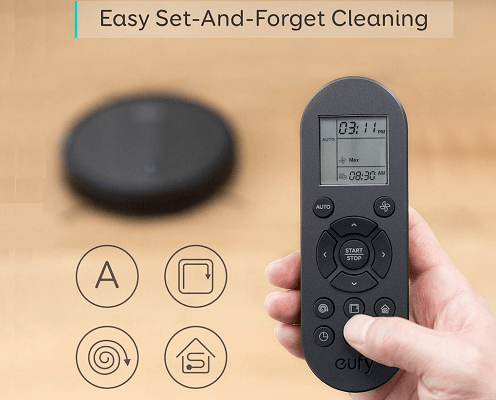
The remote has an LCD screen so that you can see the date and time, as well as the selected scheduling periods when you create or remove a schedule. There are also mode selection options.
You can choose to have the robot do an automatic cleaning cycle which will send it out to your home and have your floors cleaned in the manner it deems best. This results in a sporadic cleaning pattern that eventually covers the entire floor.
You can also select spot cleaning mode for, particularly heavily soiled areas. The robot will concentrate on a single spot, spiraling outward to about a two-foot radius deep cleaning that area.
Finally, you can choose the edge cleaning mode. This will force the robot to find the wall and run along the baseboards of your home cleaning only the edges. If you have shedding pets, this is a must-have option as their hair seems to somehow find its way to the corners and edges of the home.
The Ecovacs N79S doesn’t have a remote control. Instead, they use wireless communications to connect to your home network. You can use this connection to sync the mobile app on your phone to the robot and control it that way.
The mobile app isn’t the greatest version of a robotic remote control out there, but it gets the job done. You will be able to select all the same cleaning modes that the Eufy has: automatic, spot cleaning and edge cleaning.
You can also start a cleaning cycle, pause, resume or cancel a cycle in progress or make the robot return to the charging station. Using the app, you can also activate max cleaning mode, at any time, which increases the motor speed and suction power up to double the normal rates.
You will see the status of the robot and the battery charge level as well. You will also have the opportunity to create, edit or delete a cleaning schedule. These schedules can be added at any time from anywhere as long as your phone is connected to a network.
You can even make a schedule while you are at the office to have the robot clean your homes while you are at work.
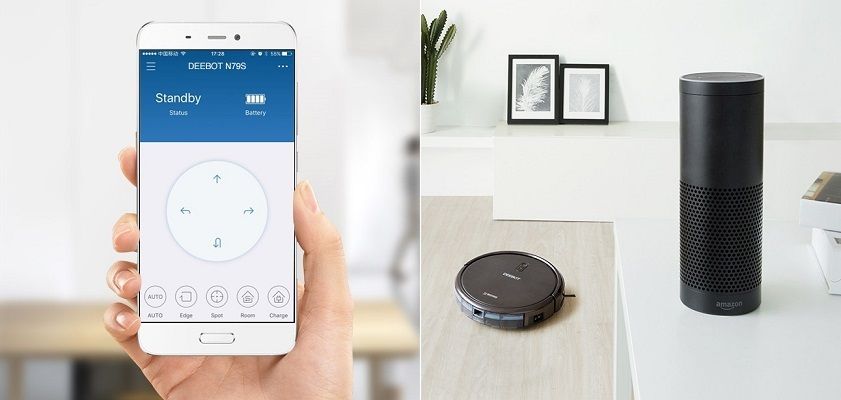
The use of the wireless network also enables you to sync the robot to Amazon Alexa enabled devices and other third-party, voice-controlled apps such as Google Home and IFTTT. Doing so you can then control the robot with your voice.
The voice commands are limited, but offer you the ability to locate the robot, check the status, and start, pause, resume or stop a cleaning cycle and send the robot to the charging station.
Bottom Line: Ecovacs wins this round. While the Eufy remote is sufficient, mobile apps and voice controls are easier and can be used in more instances.
One Filter Sounds Impressive; The Other Actually Is Impressive.
The Eufy 11S uses what they call a high-performance filter. While this may sound impressive, it is a fairly standard filter overall.
The filter isn’t HEPA certified or even HEPA quality. It is a three-stage filter, but at most will only capture particles down to 5 microns in size. This means that most of the in-home allergens will get through, make it past the exhaust and back into your home, settling on the floor.
If you suffer allergies, things like pet dander, dust mites and pollen that are tracked into your home will remain, to some degree. For keeping the motor area clean, and the floors picked up, though, the filters do their job.
I should note here: The replacement filters you can get fromt eh Eufy website are HEPA quality. They aren’t HEPA certified, (a lot of robot vendors stopped doing the certification), but still collect particles down to 3 microns.
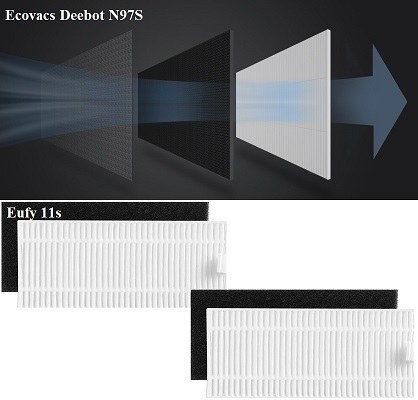
If you are looking for HEPA quality filters, though, the Ecovacs Deebot N79S has you covered. Their three stage filter is finished off with a HEPA certified filter to collect particles down to 3 microns in size.
This will capture up to 99 percent of all in-home allergens. While it won’t replace your home’s filtration system (and you shouldn’t expect it to), the filter will collect and keep these allergens from the floors and carpeting in your home.
Bottom Line: The N79S wins. HEPA filtration is better than not.
Neither the 11S nor the N79S will map your home using lasers or cameras. These expensive additions are only found on high-end models such as the Roomba 980 and The Neato BotVac Connected line.
What you get, instead, is sensor based navigation, which can make the robot appear to be sporadic and random. This form of navigation is the most simplistic and rudimentary method available. It is still around for one simple reason: it just works.
The drop sensors on both of the robots prevent them from falling down stairs or getting caught on large ledges. Large, of course meaning a threshold or barrier with a height difference of about an inch and a half.
The infrared beams detect ledges and drops and, if found, will force the robot to stop and change direction.
The robots also have bump sensors that alert the robot that an obstacle is approaching, such as furniture legs or walls. The acoustic sensors will detect the object and the robot will slow its movement.
It will generally (though not always) make contact to see if the object is passable (such as drapes or bed skirting). If so, the robot will soldier on. If it is not, the robot will change direction. The rubber bumpers around the robots prevent damage to walls, furniture and the robots themselves.
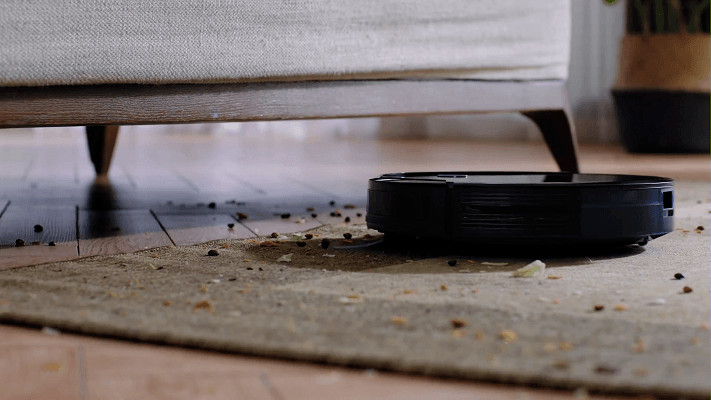
The Eufy 11s has an extra sensor that the Ecovacs N79S doesn’t have: Carpeting sensors. When the Eufy senses that it is on a carpet, it will boost it’s motor speed and suction power (up to 1300pa instead of the normal 800pa) to agitate carpet fibers and collect deeper embedded dirt and debris.
Bottom Line: Eufy wins this time. The extra sensors put it over the top, even if it is a simple sensor.
Frequently Asked Questions
Let me answer some of the more common questions that potential consumers have for these two robots. If your question still hasn’t been answered, please feel free to ask in the comments section below.
Q. What do the letters in the model names mean? Are they important?
A. They really aren’t that important. They are just model names. However, since you asked I spent all of a whole 4 minutes to look it up for you.
The Eufy 11S is named so because it is the 11 series version that is the smallest in stature. So, of course, the S stands for “Slim.” The full, complete name, if you are interested (because of the carpet sensors boosting the motor and suction is Eufy BoostIQ 11S. Fun!
The Deebot N79S is pretty similar. The N79 is the series the robot is in. The S, in this instance stands for Smart. This is because it contains the ability to use the wireless communications, syncing to the mobile app and voice controls.
Some also say that it stands for Syncing, Superior or even Suction (because of the max mode), however, no official word from Ecovacs has come down the line and the consensus is on Smart. You can pretend it stands for whatever you would like, though.
The full name for this one is Ecovacs DeeBot N79S. Fun!
Q. I heard the N79S only works with Amazon Alexa and nothing else, is this true?
A. Yes and no. How is that for confusing? As of this writing, it is true. However, Ecovacs has released updates to several beta tests (I wasn’t one of them, unfortunately.) that connect and are controlled through Google home and SmartThings hubs, including connectivity through IFTTT recipes.
As soon as the beta testing is complete, these updates will be rolled out to all N79S units.
Q. I want my cat to ride on my robot can I…
A. Please. Just don’t.
Q. Can I wash and reuse the filters?
A. For the Eufy, you can remove and knock off the “big stuff” on all the parts of the three layer filter system. You can wash and reuse the screen filters. However the high-performance filter is not washable. You will need to replace it every 4 to 6 months of constant use.
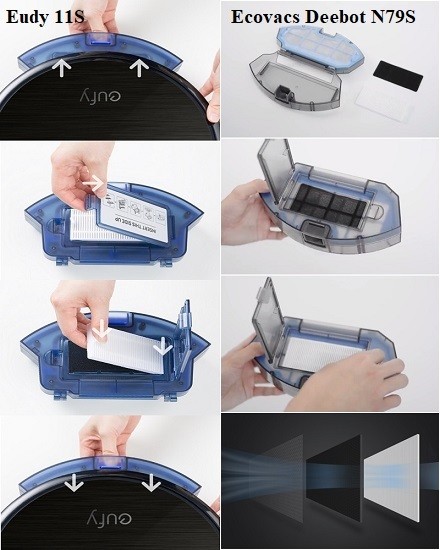
For the Ecovacs, the answer is the same. You can wash and reuse the screen style filters, the other HEPA and sponge filters will need to be replaces. Also about every six months or so.
Q. Do I have to do anything to keep the robot running right?
A. Block the right wheel and it won’t be able to go any direction except right. However, I assume you mean maintenance duties. Yes, you have to perform regular maintenance.
For both machines you will need to regularly clean out the collection bin. The Eufy bin is larger (0.6L) and after it has cleaned your home a few times you will notice it fills up less and less. Eventually you may get to the point where you can empty it only after every second or third cleaning cycle.
The smaller Ecovacs bin (0.3L) will need to be cleaned out after every cleaning cycle.
Aside from that you will need to check the filters regularly, ensure they are cleaned or replaced as needed. You will also need to clean the brush rolls from tangles and debris caught there. While doing that, you should visually check the suction port and clear out any clogs in the ducting.
Finally you will need to regularly clean off the sensors so that dust build up and such don’t prevent them from working correctly.
Regular maintenance should be completed weekly for inspections and filters and monthly for everything else, cleaning as needed even if ahead of schedule.
What I Like About the Eufy
- Easy to control and schedule with the remote.
- Three cleaning modes for all manner of home floor cleaning.
- The battery is strong enough to clean up to 1400 square feet.
What I Like About the Ecovacs N79S
- HEPA quality filtration.
- The use of mobile apps and voice controls on an entry-level robot.
- Max mode can be activated at any time.
In Conclusion
If you want a mid-tier clean with an entry-level robot, the Eufy 11S or the Ecovacs N79S make good choices. Each has it’s own good and bad that may deter certain people from making a purchase, however, of the price and abilities, you really can’t go wrong.
If you aren’t worried about in-home allergens, nor do you want or need to fuss with technological controls, the Eufy 11S could be your answer. It will clean your entire floors space, edges, baseboards and carpets (low and medium pile only) and it will do so effectively and efficiently.
However, the Ecovacs N79S will do the same (except on low pile carpet only, not medium or high pile), and give you more control options. You will also have the added benefit of HEPA certified filtration.
In the end, the right choice will be the one that works best for your situation. If you leave it up to me, though, I will choose the Ecovacs N79S over the Eufy 11S every time.
Click here for all the robot vacuum deals on Amazon today.
